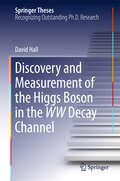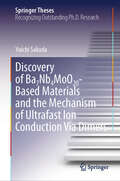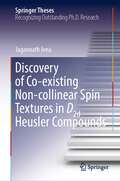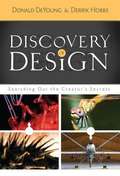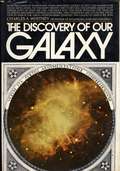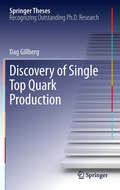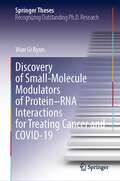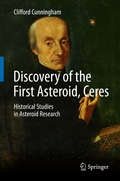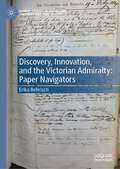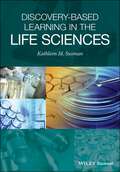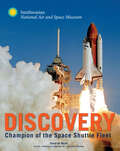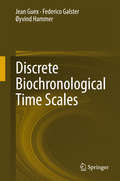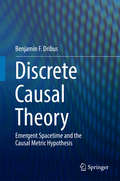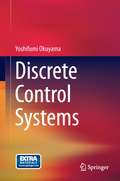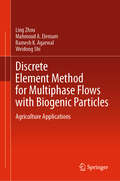- Table View
- List View
Discovery Works (California Edition)
by Catherine Valentino William Badders Carolyn Sumners Donald Peck Lowell J. Bethel Victoria FuFind answers to questions like--How Do Wind and Ice Shape the Land?, Why Is Soil an Important Resource?, Why Are Rocks and Minerals Important?, What Do People Throw Away, and Where Does It Go?, How Can Trash Affect Resources? , What Is an Ecosystem?, How Are Living Things in an Ecosystem Related?, How Does Energy Flow in an Ecosystem?, How Is Matter Cycled in an Ecosystem?. A very descriptive book with lot of activities to explain things.
Discovery Works (Grade #4)
by Catherine Valentino William Badders Carolyn Sumners Donald Peck Lowell J. Bethel Victoria Fu R. Mike MullaneTopics broadly covered in this book are: earth's land resources, properties of matter, magnetism & electricity, weather & climate and the body's delivery systems.
Discovery Works (Unit B, Sun, Moon and Earth)
by Houghton MifflinIf you want to learn about the sun, moon and earth this will book will be a good start.
Discovery Works (Unit B, The Solar System and Beyond)
by Houghton MifflinTopics covered in this book are: exploring the night sky, solar system, stars, galaxies and living in space.
Discovery Works Florida Edition (Discovery Works, Grade 2)
by Badders*This textbook has been transcribed in UEB, formatted according to Braille textbook formats, proofread and corrected. <P><P>
Discovery Works Science (Grade #6)
by Catherine Valentino William Badders Carolyn Sumners Donald Peck Lowell J. Bethel Victoria FuThe text contains unit lessons on: Cells and Microbes, The Changing Earth, The Nature of Matter, Continuity of Life, Oceanography, Forces and Motion, Growing Up Healthy, etc.
Discovery Works Unit C: Classifying Living Things Level 4
by Houghton MifflinClassification involves observing the animal, identifying its traits and characteristics then categorizing it for ease study.
Discovery Works: The Nature Of Matter
by Silver Burdett GinnTo think like a scientist, you should learn as much as you can by observing things around you, everything you hear and see is a clue about how the natural world works.
Discovery Works: Unit D Earth's Resources Level 3
by Houghton MifflinA third grade science workbook on the earth's resources.
Discovery and Classification in Astronomy
by Steven J. DickAstronomical discovery involves more than detecting something previously unseen. The reclassification of Pluto as a dwarf planet in 2006, and the controversy it generated, shows that discovery is a complex and ongoing process - one comprising various stages of research, interpretation, and understanding. Ranging from Galileo's observation of Jupiter's satellites, Saturn's rings, and star clusters, to Herschel's nebulae and the modern discovery of quasars and pulsars, Steven J. Dick's comprehensive history identifies the concept of "extended discovery" as the engine of progress in astronomy. The text traces more than 400 years of telescopic observation, exploring how the signal discoveries of new astronomical objects relate to and inform one another, and why controversies such as Pluto's reclassification are commonplace in the field. The volume is complete with a detailed classification system for known classes of astronomical objects, offering students, researchers, and amateur observers a valuable reference and guide.
Discovery and Measurement of the Higgs Boson in the WW Decay Channel
by David HallThis thesis describes the stand-alone discovery and measurement of the Higgs boson in its decays to two W bosons using the Run-I ATLAS dataset. This is the most precise measurement of gluon-fusion Higgs boson production and is among the most significant results attained at the LHC. The thesis provides an exceptionally clear exposition on a complicated analysis performed by a large team of researchers. Aspects of the analysis performed by the author are explained in detail; these include new methods for evaluating uncertainties on the jet binning used in the analysis and for estimating the background due to associated production of a W boson and an off-shell photon. The thesis also describes a measurement of the WW cross section, an essential background to Higgs boson production. The primary motivation of the LHC was to prove or disprove the existence of the Higgs boson. In 2012, CERN announced this discovery and the resultant ATLAS publication contained three decay channels: gg, ZZ, and WW.
Discovery of Ba7Nb4MoO20-Based Materials and the Mechanism of Ultrafast Ion Conduction Via Dimers (Springer Theses)
by Yuichi SakudaThis book provides detailed descriptions of strategies for improving ion conductivity and the factors that result in high ion conductivity. In this book, discovery of novel materials that exhibit higher ion conductivity than practical materials is introduced to clarify the migration mechanism of oxide ions and protons. The book shows that the bulk conductivity of hexagonal perovskite-related oxide Ba7Nb3.8Mo1.2O20.1 in dry air is 1.1 mS/cm at 306 °C, which is 175 times higher than that of practical materials (ZrO2)0.92(Y2O3)0.08 (8YSZ). Also, as a new approach to the subject, by ab initio molecular dynamics (AIMD) simulations and neutron-diffraction experiments, the mechanism is shown that the oxide ions migrate by the breaking and reforming of M2O9 (M = Nb, Mo) dimers, MO5 monomers and MO4 tetrahedra. The oxide-ion migration is reminiscent of a concerted push-pull interstitialcy ‘bucket-relay’-type motions. Readers can understand the oxide-ion and proton migration mechanism in terms of crystal structure. Recently, materials that exhibit high ionic conductivity have been discovered one after another.
Discovery of Co-existing Non-collinear Spin Textures in D2d Heusler Compounds (Springer Theses)
by Jagannath JenaNon-collinear spin textures have attracted significant attention due to their topological nature, emergent electromagnetic properties, and potential spintronic and magnonic device applications. This book explores the physical properties of distinct spin textures in D2d compounds. The main goals of the work are (a) discovering new spin textures in D2d Heusler compounds and studying their detailed properties to enrich the field of non-collinear magnetism (b) optimizing the nano-track geometry and generating isolated and single chains of nano-objects that will establish new hallmarks for technological applications (c) studying the stability of spin textures with magnetic fields and temperatures and finding a way to observe the striking behavior of spin textures near the specimen edges. The first few chapters provide a brief overview of spin textures such as Bloch and Néel skyrmions. In the experimental methods section, the author shows how to identify the single-crystalline grains of a polycrystalline sample, how to make single-crystalline thin specimens and nano-tracks, and then provides explicit descriptions of different imaging techniques performed on a transmission electron microscope. This part will be valuable for beginners wishing to conduct research in experimental nano-magnetism and transmission electron microscope imaging. The core results of the book are presented in four chapters, describing the discovery of several new and unanticipated spin textures, namely square-shaped antiskyrmions, elliptical Bloch skyrmions, fractional antiskyrmions, fractional Bloch skyrmions and elongated (anti)skyrmions in a single D2d Heusler compound. It is shown that these textures can be understood by a combination of dipole-dipole interactions and a chiral vector exchange that makes it possible to stabilize various spin textures even in the same compound. The D2d compounds are the first non-centrosymmetric systems shown to host several co-existing non-collinear spin textures.
Discovery of Design
by Dr Donald Deyoung Derrik HobbsA world created in perfection, now unveiled... From the frontiers of scientific discovery, researchers are now taking design elements from the natural world and creating extraordinary breakthroughs that benefit our health, our quality of life, our ability to communicate, and even help us work more efficiently. An exciting look at cutting-edge scientific advances, Discover of Design highlights incredible examples that include: How things like batteries, human organ repair, microlenses, automotive engineering, paint, and even credit card security all have links to natural designs Innovations like solar panels in space unfurled using technology gleaned from beech tree leaves, and optic research rooted in the photonic properties of opal gemstones Current and future research from the fields of stealth technology, communications, cosmetics, nanotechnology, surveillance, and more! Take a fantastic journey into the intersection of science and God's blueprints for life - discovering answers to some of the most intricate challenges we face. Experience this powerful apologetics message in a multi-purpose resource as a personal enrichment tool or as an educational supplement.
Discovery of Our Galaxy
by Charles A. WhitneyThis is a book about the mystery and the passion, the imagination, religion, and poetry, the philosophy, the intellectual flights--and, above all, the people--that have created the science of astronomy, from Thales of Miletus predicting eclipses in the sixth century B.C. to today's scientists probing the cosmic significance of the mysterious "black holes" discovered in 1970. With authority and charm, the distinguished Harvard astronomer Charles A. Whitney here re-creates the lives and temperaments of the great astronomers and retraces the ingenious arguments, the feats of observation and deduction, and the leaps of intuition by which they have gradually unveiled a picture of the universe and have brought us to an understanding of our own planet's place in it. Among them: KEPLER, searching the solar system for visible evidence of the transcendent order he believed inGALILEO, constructing the first telescope and proposing the concept of universal gravitationNEWTON, paragon of logic, paradoxically driven by an unshakable belief in himself as God's appointed prophet to create a world of mathematical certainty and thus expose the wonder of his Father in HeavenWILLIAM HERSCHEL, the nineteenth-century German who may well be considered the father of modern astronomy, first man to chart the nebulaeEDWIN HUBBLE, in the present century, discovering and exploring galaxies beyond our own Finally, Professor Whitney makes clear for the layman the fascinating problems astronomers wrestle with today: the mysterious nature of quasars, strange cosmic bodies discovered in 1963; the unknown forces behind cataclysmic explosions recently glimpsed in other galaxies; the elusive nature of "interstellar dust"; the eternal question of how it all began.
Discovery of Single Top Quark Production
by Dag GillbergThe top quark is by far the heaviest known fundamental particle with a mass nearing that of a gold atom. Because of this strikingly high mass, the top quark has several unique properties and might play an important role in electroweak symmetry breaking--the mechanism that gives all elementary particles mass. Creating top quarks requires access to very high energy collisions, and at present only the Tevatron collider at Fermilab is capable of reaching these energies. Until now, top quarks have only been observed produced in pairs via the strong interaction. At hadron colliders, it should also be possible to produce single top quarks via the electroweak interaction. Studies of single top quark production provide opportunities to measure the top quark spin, how top quarks mix with other quarks, and to look for new physics beyond the standard model. Because of these interesting properties, scientists have been looking for single top quarks for more than 15 years. This thesis presents the first discovery of single top quark production. It documents one of the flagship measurements of the D0 experiment, a collaboration of more than 600 physicists from around the world. It describes first observation of a physical process known as "single top quark production", which had been sought for more than 10 years before its eventual discovery in 2009. Further, his thesis describes, in detail, the innovative approach Dr. Gillberg took to this analysis. Through the use of Boosted Decision Trees, a machine-learning technique, he observed the tiny single top signal within an otherwise overwhelming background. This Doctoral Thesis has been accepted by Simon Fraser University, Burnaby, BC, Canada.
Discovery of Small-Molecule Modulators of Protein–RNA Interactions for Treating Cancer and COVID-19 (Springer Theses)
by Wan Gi ByunThis book describes the development of novel protein–RNA-binding assays and their applications in a high-throughput manner for the identification of small-molecule modulators of protein–RNA interactions to treat cancer and COVID-19. Modulating protein–RNA interactions with small molecules is expected to provide novel biological insights of the interrelation of diseases with the protein–RNA interactome. The modulations may also be exploited therapeutically. For these reasons, the development of a simple, reliable, and sensitive protein–RNA-binding assay is necessary for high-throughput screening to discover new effective chemical entities capable of acting on diverse protein–RNA interactions. This book discusses the discovery of small-molecule modulators targeting protein–RNA interactions that are potentially valuable to treat cancer and COVID-19 by constructing novel high-throughput screening methods. The results of this dissertation provide valuable insights into the regulation of protein–RNA interactions in chemical biology and drug development.
Discovery of the First Asteroid, Ceres
by Clifford CunninghamBased on extensive primary sources,many never previously translated into English, this is the definitive accountof the origins of Ceres as it went from being classified as a new planet toreclassification as the first of a previously unknown group of celestialobjects. Cunningham opens this critical moment of astronomical discovery tofull modern analysis for the first time. This book includes all the voluminouscorrespondence, translated into English, between the astronomers of Europeabout the startling discovery of Ceres by Piazzi in 1801. It covers the periodup to March 1802, at which time Pallas was discovered. Also included arePiazzi's two monographs about Ceres, and the sections of two books dealing withCeres, one by Johann Bode, the other by Johann Schroeter. The origin of theword 'asteroid' is explained, along with several chapters on the antecedents ofthe story going back to ancient Greek times. The formulation of Bode's Law isgiven, as are the details on the efforts of Baron von Zach to organize a searchfor the supposed missing planet between Mars and Jupiter. Examples of versecreated to commemorate the great discovery are included in this first volume. The author, who has a PhD in the History of Astronomy, is a dedicated scholarof the story of asteroids and his research on the discovery of Ceres iscomprehensive and fully sourced. The discovery came at a time when rivalastronomers were in hot competition with each other, and when the true natureof these celestial bodies was not yet known. With astronomers in France, Italyand beyond vying to understand and receive credit for the new class of astralbodies, drama was not in short supply--nor were scientific advances.
Discovery, Innovation, and the Victorian Admiralty: Paper Navigators (Global Studies in Social and Cultural Maritime History)
by Erika BehrischThis book examines the British Admiralty’s engagement with science and technological innovation in the nineteenth century. It is a book about people, and gross misunderstanding, about the dreams and disappointments of scientific workers and inventors in relation to the administrators who adjudicated their requests for support, and about the power of paper to escalate arguments, reduce opinions, and frustrate hopes. From instructions for naval surveying to debates about rewards to civilians for inventions, Paper Navigators puts a wide range of primary sources in the context of public debates and explores the British Admiralty’s engagement with, decision-making around, and management of questions of value, support, and funding with citizen inventors, the broader public, and their own employees. Concentrating on the Admiralty’s private, internal correspondence to explore these themes, it offers a fresh perspective on the Victorian Navy's history of innovation and exploration and is a novel addition to literature on the history of science in the nineteenth century.
Discovery-Based Learning in the Life Sciences
by Kathleen M. SusmanFor nearly a decade, scientists, educators and policy makers have issued a call to college biology professors to transform undergraduate life sciences education. As a gateway science for many undergraduate students, biology courses are crucial to addressing many of the challenges we face, such as climate change, sustainable food supply and fresh water and emerging public health issues. While canned laboratories and cook-book approaches to college science education do teach students to operate equipment, make accurate measurements and work well with numbers, they do not teach students how to take a scientific approach to an area of interest about the natural world. Science is more than just techniques, measurements and facts; science is critical thinking and interpretation, which are essential to scientific research. Discovery-Based Learning in the Life Sciences presents a different way of organizing and developing biology teaching laboratories, to promote both deep learning and understanding of core concepts, while still teaching the creative process of science. In eight chapters, the text guides undergraduate instructors in creating their own discovery-based experiments. The first chapter introduces the text, delving into the necessity of science education reform. The chapters that follow address pedagogical goals and desired outcomes, incorporating discovery-based laboratory experiences, realistic constraints on such lab experiments, model scenarios, and alternate ways to enhance student understanding. The book concludes with a reflection on four imperatives in life science research-- climate, food, energy and health-- and how we can use these laboratory experiments to address them. Discovery-Based Learning in the Life Sciences is an invaluable guide for undergraduate instructors in the life sciences aiming to revamp their curriculum, inspire their students and prepare them for careers as educated global citizens. imperatives.
Discovery: Champion of the Space Shuttle Fleet
by Valerie NealThis book places Space Shuttle Discovery within the history of the space shuttle program and provides an introduction to space shuttle technology, with a focus on the orbiter itself. Discovery's unique history is presented mission by mission that includes a brief narrative of each mission, a chart of its key statistics (dates, duration, altitude, payloads, etc.), each mission's patch with an explanation of its unique symbolism, a crew portrait, and two to four iconic photos that capture the distinct activities and successes of each mission. The book also features anecdotes and memories of several astronauts who flew on Discovery, as well as its modernization over the years and its final preparation for retirement at the Smithsonian.
Discrete Biochronological Time Scales
by Jean Guex Federico Galster Øyvind HammerThe object of this book is to explain how to create a synthesis of complex biostratigraphic data, and how to extract from such a synthesis a relative time scale based exclusively on the fossil content of sedimentary rocks. Such a time scale can be used to attribute relative ages to isolated fossil-bearing samples. The book is composed of 10 chapters together with several appendices. It is a totally revised version of "Biochronological Correlations" published in 1991 and includes various new chapters. The book offers a solution for the theoretical problem of how fossils can be used to make reliable quantitative stratigraphic correlations in sedimentary geology. It also describes the use of highly efficient software along with several examples. The authors compare their theoretical model with 2 other relevant studies: probabilistic stratigraphy and constrained optimization (CONOP).
Discrete Causal Theory
by Benjamin F. DribusThis book evaluates and suggests potentially critical improvements to causal set theory, one of the best-motivated approaches to the outstanding problems of fundamental physics. Spacetime structure is of central importance to physics beyond general relativity and the standard model. The causal metric hypothesis treats causal relations as the basis of this structure. The book develops the consequences of this hypothesis under the assumption of a fundamental scale, with smooth spacetime geometry viewed as emergent. This approach resembles causal set theory, but differs in important ways; for example, the relative viewpoint, emphasizing relations between pairs of events, and relationships between pairs of histories, is central. The book culminates in a dynamical law for quantum spacetime, derived via generalized path summation.
Discrete Control Systems
by Yoshifumi OkuyamaDiscrete Control Systems establishes a basis for the analysis and design of discretized/quantized control systems for continuous physical systems. Beginning with the necessary mathematical foundations and system-model descriptions, the text moves on to derive a robust stability condition. To keep a practical perspective on the uncertain physical systems considered, most of the methods treated are carried out in the frequency domain. As part of the design procedure, modified Nyquist-Hall and Nichols diagrams are presented and discretized proportional-integral-derivative control schemes are reconsidered. Schemes for model-reference feedback and discrete-type observers are proposed. Although single-loop feedback systems form the core of the text, some consideration is given to multiple loops and nonlinearities. The robust control performance and stability of interval systems (with multiple uncertainties) are outlined. Finally, the monograph describes the relationship between feedback-control and discrete event systems. The nonlinear phenomena associated with practically important event-driven systems are elucidated. The dynamics and stability of finite-state and discrete-event systems are defined. Academic researchers interested in the uses of discrete modelling and control of continuous systems will find Discrete Control Systems instructive. The inclusion of end-of-chapter problems also makes the book suitable for use in self study either by professional control engineers or graduate students supplementing a more formal regimen of learning.
Discrete Element Method for Multiphase Flows with Biogenic Particles: Agriculture Applications
by Ling Zhou Ramesh K. Agarwal Weidong Shi Mahmoud A. ElemamThis book presents the advanced theory and application of the combined Computational Fluid Dynamics – Discrete Element Method (CFD-DEM) to multiphase flow simulations of the gas and bio-particulate matter of non-uniformly shaped biomass. It explores how DEM can simulate the complex behaviour of biomass particles, such as their packing in the multiphase flows that occurs in the agricultural product processing industries. It offers an overview of aerodynamic systems, such as cyclone separators, used in the agricultural processing industry. A detailed description of DEM modeling, including the particle-particle, particle-boundary, and particle-fluid interactions in the context of biomass particles of varying sizes and shapes, is provided. Coverage includes the critical application of CFD-DEM simulation technology in designing and optimizing grain handling and processing equipment and the application of extended DEM to other granular flows of complex particles like sand, powders, and dust from mines where clumping and agglomeration occur. The application of DEM in modeling and simulation of complex multiphase systems can help improve productivity, reduce costs, and increase efficiency in the agricultural industry.

